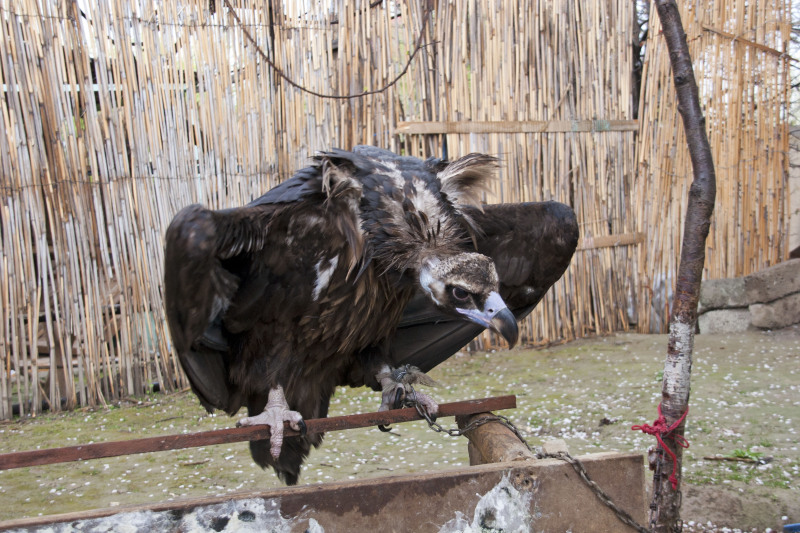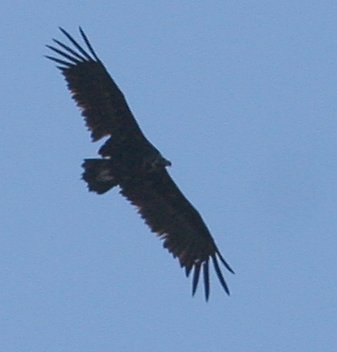Distinguishing features
The Cinereous Vulture is distinctly dark, with the whole body being dark brown excepting the pale head in adults, which is covered in fine blackish down, which is absent in the closely related Lappet-faced Vulture (Torgos tracheliotos).
The skin of the head and neck is bluish-gray and a paler whitish color above the eye. The adult has brown eyes, a purplish cere, a blue-gray bill and pale blue-gray legs.
The primary quills are often actually black. From a distance, flying birds can easily appear all black. The immature plumage is sepia-brown above, with a much paler underside than in adults. Immature Cinereous Vultures have grey down on the head, a pale mauve cere and grey legs. The massive bill is the largest of any living accipiterid, a feature enhanced by the relatively small skull of the species.
The wings, with serrated leading edges, are held straight or slightly arched in flight and are broad. Their flight is slow and buoyant, with deep, heavy flaps when necessary. The combination of huge size and dark coloration renders the Cinereous Vulture relatively distinct, especially against smaller raptors such as eagles or hawks. (Wikipedia)
Size
- Up to 120 cm (Length of specimen)
Wingspan
- Up to 310 cm
Synonyms
Interesting facts
- The Cinereous Vulture is believed to be the largest true bird of prey in the world. The condors, which may be marginally larger, are now generally considered unrelated to the true raptors. The Himalayan Griffon Vulture (Gyps himalayensis) is the only close extant rival to the size of the Cinereous, with a similar average wingspan, weight and a longer overall length, thanks to a distinctly longer neck. The largest Cinereous vultures exceed the weight and wingspan of the largest Himalayan Griffon, and the Cinereous is the larger species going on standard measurements. (Wikipedia)
Distribution
Distribution and habitat preferences
The Cinereous Vulture is a Eurasian species. The western limits of its range are in Spain and inland Portugal, with a reintroduced population in south France. They are found discontinuously to Greece, Turkey and throughout the central Middle East. Their range continues through Afghanistan eastwards to northern India to its eastern limits in central Asia, where they breed in northern Manchuria, Mongolia and Korea. Their range is fragmented especially throughout their European range. It is generally a permanent resident except in those parts of its range where hard winters cause limited altitudinal movement and for juveniles when they reach breeding maturity. In the eastern limits of its range, birds from the northernmost reaches may migrate down to southern Korea and China. A limited migration has also been reported in the Middle East but is not common.
This vulture is a bird of hilly, mountainous areas, especially favoring dry semi-open habitats such as meadows at high altitudes over much of the range. Nesting usually occurs near the tree line in the mountains. They are always associated with undisturbed, remote areas with limited human disturbance. (Wikipedia)


